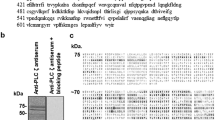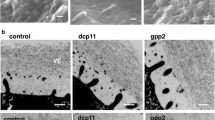Abstract
The 24p3 protein is a 25 kDa glycoprotein that is secreted into the uterine fluid during the proestrous phase of mice. We assessed the effects on spermatozoa motility and on the functions of mouse spermatozoa using the computer-assisted sperm analysis method, cytochemical staining and detection of the protein tyrosine phosphorylation pattern. Compared with the control cells, sperm motility was stimulated by the addition of 24p3 protein into the medium. Introducing 24p3 protein enhanced progressive motility but did not promote the appearance of hyperactivated movement. The presence of 24p3 protein in the medium did not allow the cells to undergo the capacitated protein tyrosine phosphorylation pattern and acrosome reaction. The tyrosine phosphorylation pattern shows phosphoproteins in the range of Mr 50000–106000 correlated with the sperm progressive motility after the addition of 24p3 protein into the medium. Using flow cytometry, we assessed the changes in the intracellular pH and measured the intracellular cAMP concentration with an immunodetection kit. The results indicated that the elevation in intracellular pH from 6.67 to 6.89, increase of intracellular cAMP accumulation, and protein tyrosine phosphorylation might be the factors in enhancement of sperm motility as the 24p3 protein bound to the spermatozoa. The 24p3 protein may have a role in regulating flagellar motility.
Similar content being viewed by others
References
Hraba-Renevey S, Trler H, Kress M, Saloman C, Weil R (1989). Oncogene. 4: 601–608.
Flower DR, North ACT, Attword TK (1991) Biochim. Biophys. Res. Commun. 180: 69–74.
Chu ST, Lin HJ, Huang HL, Chen YH (1998) J. Peptide Res. 52: 390–397.
Meheus LA, Fransen LM, Raymackers JG, Blockx HA, van Bearrmen JJ, van Ban SM, van de Voorde A (1993) J. Immunol. 151: 1535–1547.
Davis TR, Tabatabai L, Bruns K, Hamilto RT, Nilsen-Hamilton M (1991) Biochim. Biophys. Acta. 1095: 145–152
Liu Q, Nilsen-Hamilton M (1995) J. Biol. Chem. 270: 22565–22570.
Cowland JB, Borregarrd N (1997) Genomics 45: 17–23.
Chu ST, Lin HJ, Chen YH (1997) J. Peptide Res. 49: 582–585.
Åkerstrom B, Flower DR, Salier J-P (2000) Biochem. Biophy.Acta. 1482: 1–8.
Huang HL, Chu ST, Chen YH (1999) J. Endocrinol. 162: 11–19.
Chu ST, Huang HL, Chen JM, Chen YH (1996) Biochem. J. 316: 545–550.
Chu ST, Lee YC, Nein KM, Chen YH (2000) Mol. Reprod.Dev. 57: 26–36.
Pusch HH (1987) Andrologia. 19: 514–527.
Fraser LR (1995) Human. Reprod. Suppl. 10: 22–30.
Robertson L, Kay VJ (1998) Human. Reprod. Update 4: 776–786.
Jaiswal BS, Majumder GG (1998) Reprod. Fertil. Dev. 10: 299–307.
Leclerc P, de Lamirande E, Gagnon C (1996) Biol. Reprod. 55: 684–692.
Lee MA, Storey BT (1986) Biol. Reprod. 34: 349–356.
Neill JM, Olds-Clarke P. (1987) Gamete Res. 18: 121–140.
Si Y, Olds-Clark P. (2000) Biol. Reprod. 62: 1231–1239.
Aarons D, Battle T, Boettger-Tong H, Holt G, Poirier GR (1991) Mol. Reprod. Dev. 30: 258–264.
Moller CC, Bleil JD, Kinloch RA, Wassarman PM (1990) Dev.Biol. 137: 276–286.
Màriàn T, Krasznai Z, Balkay L, Emri M, Tròn L (1997) Cytometry 27: 374–382.
Cross NL, Razy-Fanlkne RP (1997) Biol. Reprod. 56: 1169–1174.
Visconti PE, Bailey JL, Moore GD, Pan D, Olds-Clarke P, Kopf GS (1995) Development 121: 1129–1137.
Laemmli UK (1970) Nature 227: 680–685.
Towbin H, Staehelin TH, Gordan J (1979) Proc. Natl. Acad. Sci. USA. 76: 4350–4354.
Cancel AM, Lobdell D, Mendola P, Perreault D (2000) Human. Reprod. 15: 1322–1328.
Galantino-Homer HL, Visconti PE, Kopf GS (1997) Biol. Reprod. 56: 707–719.
Lee HC, Johnson C, Epel D (1983) Dev. Biol. 95: 31–45.
Kalab P, Visconti PE, Leclerc P, Kopf GS (1994) J. Biol. Chem. 269: 3810–3817.
Fraser LR, McDermott CA (1992) J. Reprod. Fertil. 96: 363–377.
Carr DW, Acoh TS (1989) Biol. Reprod. 41: 907–920.
Beltran C, Zapata O, Darszon A (1996) Biochemistry. 35: 7591–7598.
Tash JS, Bracho GE (1998) Biochem. Biophy. Res. Commun. 251: 557–563.
Darszon A, Labarca P, Nishigaki T, Espinosa F (1999) Physiol. Rev. 79: 481–510.
Author information
Authors and Affiliations
Rights and permissions
About this article
Cite this article
Lee, YC., Liao, CJ., Li, PT. et al. Mouse lipocalin as an enhancer of spermatozoa motility. Mol Biol Rep 30, 165–172 (2003). https://doi.org/10.1023/A:1024985024661
Issue Date:
DOI: https://doi.org/10.1023/A:1024985024661




